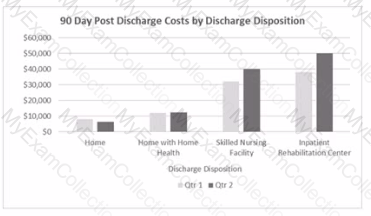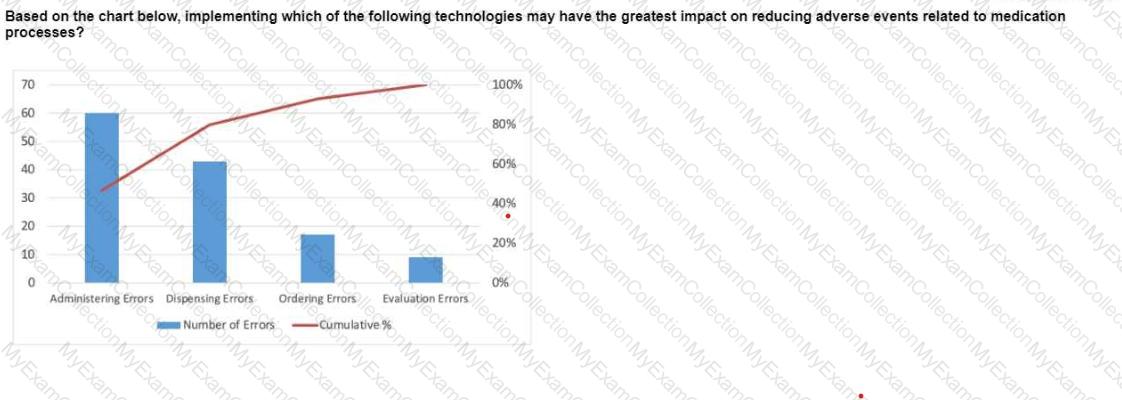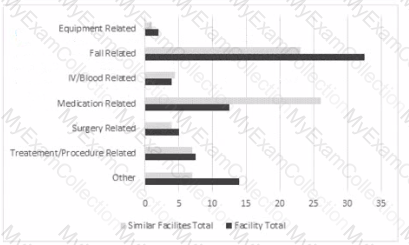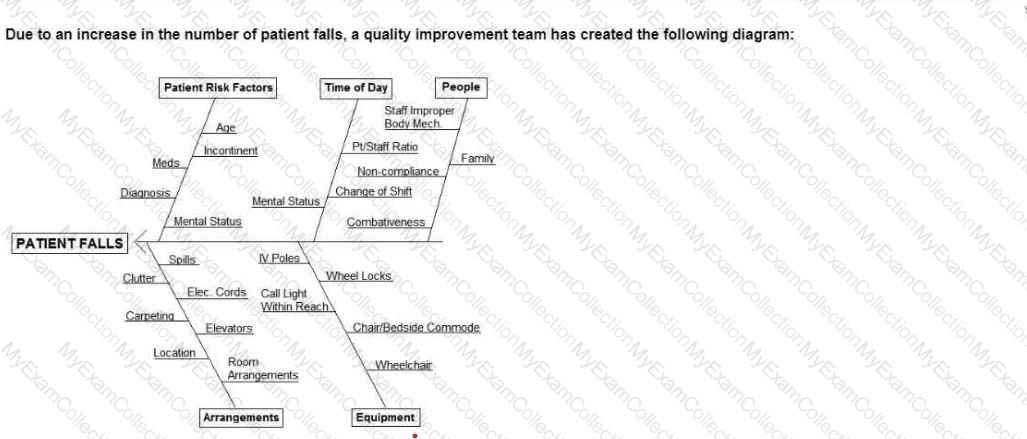Why is it important to convene a multidisciplinary team when conducting a failure mode and effects analysis (FMEA)?
An improvement project was implemented to expand utilization of primary care services in a rural area where only 5% of residents sought primary care. The team established a goal of 20% of residents using primary care. The table below shows the results for the four months following implementation of the improvement:
% Residents Using Primary Care
Time | %
Baseline | 5%
Month 1 | 15%
Month 2 | 20%
Month 3 | 21%
Month 4 | 22%
Which of the following should the quality professional recommend to the organization?
A provider’s Ongoing Professional Practice Evaluation (OPPE) profile is shown below. In this organization, if a provider partially meets or does not meet performance expectations, they are referred to peer review for a Focused Professional Practice Evaluation (FPPE).
Fully Meets: >80% of measures at threshold
Meets: 65% to 80% of measures at threshold
Partially Meets: 40% to 64% of measures threshold
Does Not Meet: <40% of measures at threshold

After reviewing this provider’s overall profile, what should the healthcare quality professional suggest?
A healthcare quality professional receives complaints from numerous patients that the registration process is inefficient. Which of the following should be used to best identify customer expectations, perceptions, and improvement opportunities?
Physician quality data reports for all credentialed physicians disseminated at regular Intervals, as generally mandated by accreditation standards, are called
To determine how much variability in a process Is due to random variation and how much Is due to unique events, the most appropriate tool would be a
An organization has implemented a quality improvement project. The goal is a mean compliance rate of 90%. The results of observations are found in the table below:

Which focus area presents the greatest opportunity for the organization?
For which incident would a process improvement manager be required to perform a root cause analysis (RCA)?
Analysis has shown that there Is a significant delay in receiving laboratory results In the emergency room. A cross-functional team Is assigned the task of Improving laboratory reporting time. Which of the following Is the next step the team should take?
A home health agency’s Performance Improvement Committee has decided to base staff educational programs on aggregated occurrence report data. Due to budgetary and time constraints, not every area identified from the data can be addressed. Which of the following would be most useful to the committee in determining their educational targets?
An organization notices an Increase In medication errors In three patient care areas. Which of the following concepts will be most effective when Improving medication administration workflows?
Using the Information below, which patient population Is at the highest risk tor tailing?

Leadership at an outpatient multi-specialty clinic Is working toward becoming a high-re I lability organization. In the past week, there have been three medication errors with high-risk medications in the procedure area. Which of the following responses by leadership Is consistent with high-reliability principles?
A recent analysis reveals that reimbursement projection Is being negatively Impacted by post-surgical respiratory failure rates. What Is the first step to address this issue?
A performance improvement team was formed to reduce the inappropriate ordering of two expensive lab tests. The goal was to reduce the rate of inappropriate ordering of Test A by 20% and Test B by 5%. The results of the pilot group showed a 30% drop in Test A orders and a 3% drop in Test B orders. What additional information would be of most benefit to gain final administrative approval to implement the change organization-wide?
The chairperson of the governing body has requested an annual report on improvements in patient care. The report should include
A patient safety manager provided training on hand hygiene guidelines. The clinical manager Is confident that staff are following the guidelines. Which of the following Is the best method to evaluate the current compliance with the guidelines?
A patient safety program can best be enhanced by which of the following technologies?
Which of the following is an example of a social determinant of health used to monitor a quality improvement initiative?
A healthcare quality professional Is facilitating the establishment of a Quality Council for an outpatient surgery center. The following positions have been selected for membership: medical director, CEO. and CFO. Which of the following Is the most appropriate Individual to add?
Which of the following tools would be used to outline factors leading to a problem or desired outcome?
An organization recently completed an analysis of safety events from the last year. The majority of events were related to the following:
• provider order transcription errors (5%)
• wrong medication given to the patient (12%)
• adverse reaction related to medication allergies (7%)
• Inappropriate medication dose administered (10%)
• delayed antibiotic administration (10%)
Which of the following would be most helpful to enhance patient safety In this organization?
A nurse inadvertently hung an IV medication on the wrong patient’s IV pump, but discovered the error prior to initiating the infusion. Patient harm was averted, and the nurse disclosed the error to a healthcare quality professional. The quality professional should
The strategic plan for an organization calls for expansion of information technology. The following information is available:

If equal weight is given to each consideration, which of the following options should be the primary choice?
Which of the following is the most effective method to identify adverse events that cause harm to patients?
An organization Is Implementing a new electronic medical record and has employed a project manager. At the first meeting, the project manager observes the following:
• The team estimates It Is one-fourth finished with Identifying benchmark organizations.
• Team members have not yet begun to identify the current state.
- They are halfway through collecting public data, which puts them slightly behind schedule for that task.
Which of the following tools should the quality Improvement project manager recommend?
One of the first steps in preparing for an organizational accreditation survey Is to have a quality professional
Which of the following is an effective method to motivate employees to participate in performance Improvement?
What Is the Initial step the quality professional should take when the organization's performance on a patient satisfaction strategic goal Is below the desired performance?
The consensus-building group of diverse stakeholders who reviews and endorses measures for public reporting in the U.S. is known as the
There is an increased incidence of type 2 diabetes among patients living near a healthcare organization as compared to the state. Considering social determinants of health, which of the following strategies can be used to address this problem?
Which of the following best describes the purpose of the nominal group technique?
Following evaluation of the compounding process used by a pharmacy, the batch compounding consistently yields 12% more drug than Is needed. The excess Is stored until used or expired. Which of the following types of waste should be recorded when reporting this finding?
An outpatient medical clinic wants to test whether a relationship exists between two factors: lack of available transportation and the number of times patients do not keep appointments. Which of the following tools should be used?
Which management accountability action should be Implemented to ensure continuous readiness tor accreditation survey?
The following information is available on a health system's performance dashboard:
Employee turnover decreased from 9% to 6%
Reporting of patient safety events and near misses increased 5%
Overall patient satisfaction increased from 58% to 61%Which of the following should the quality professional conclude as a result of this information?
A physician's profile shows a 4% readmission rate following outpatient gallbladder surgery, which Is significantly higher than the rate for their peers.
What action should the quality professional take next?
The healthcare quality professional has been asked to participate in the organizations population health program related to cost and utilization.

Based on this Information, what Is the next action the quality professional should take?
Which of the following Is the best example of effective learning in a learning organization?
Which initiative should a quality professional promote in an organization seeking to optimize value-based reimbursement?
An important responsibility of each team member working on a team project is to
An organization conducts daily briefing sessions. Which of the following questions demonstrates a culture of safety?
Which Is a source of data tor analyzing staff flu vaccination trends for an accountable care organization?
Based on the chart below, implementing which of the following technologies may have the greatest impact on reducing adverse events related to medication processes?

Data from an Incident reporting system compares Incident rates for one facility to similar facilities:

After reviewing the graph, which of the following should be done first?
A performance improvement council has been directed to set up a communication plan for spreading an innovative telehealth program throughout the healthcare system. Which of the following groups must the council include in the communication plan?
Choosing a small number of items to represent characteristics of the whole is an example of
Which of the following is the most effective means of communicating commitment to patient safety?
During the course of a root cause analysis, the team found the following Items contributed to the error:
• Fatigue and stress leading to Inattention
• Pressure to accomplish more tasks In the same amount of time
• The equipment was designed for right-handed staff
Which of the following best describe these types of causes?
Which of the following provides support and subject matter expertise (or organizations that self-report sentinel events?
Ongoing practitioner practice evaluation (OPPE) Is used for which of the following?
A new pediatric psychiatric unit will open in one year. The utilization coordinator is responsible for developing the utilization management program. The program's success will depend on which of the following factors?
Where in the process of ensuring correct surgery does a "time-out" take place?
When recommending a quality improvement project, the quality professional must first consider
Which of the following best describes how a quality professional should conduct an organizational assessment to ensure safe transitions of care?
An interdisciplinary learn met to review readmission rates at a health system. Issues were identified with communication across care providers. The team is interested in improving the coordination of care process and is now reviewing four candidates to serve in the role of process champion:

Of the four candidates, which represents the most effective choice to serve as a process champion?
The health department cited a clinic for storing used instruments improperly. From a quality perspective, which of the following should be done first?
Which of the following approaches best allows an agency to align Its activities with organizational goals?
A CEO has directed a quality improvement council to develop objectives to meet an identified goal. When developing objectives, the council must remember to
A performance Improvement team has been meeting to examine delays in getting admissions from the emergency room to the nursing units. After six months of collecting data, the upper control limit was ISO minutes, and the lower control limit was 60 minutes. The next month's data shows a time of 155 minutes. The team should understand that this represents what type of variation?
Which of the following would provide the best information to a Quality Council interested in evaluating the effectiveness of quality improvement teams that were chartered during the past year?
A local health center is launching a community health assessment. What data is recommended to identify the potential needs of the population?
A nursing home has established a quality indicator to accomplish a 5% reduction in falls. A guideline has been developed and implemented. After six months, the goal has not been reached. The next action steps should include
A hand surgeon is referred for peer review for a case of a wrong-site surgery. Which of the following professionals would be the best choice as a member of the peer review committee?
A performance improvement specialist at an ambulatory surgery center is facilitating a Plan-Do-Study-Act Cycle (PDSA) process to improve the rate of hand hygiene amongst surgical post-recovery staff to 90% or above. Data from the past 12 months are as follows:
Baseline: 60% compliance
Q1: 87% compliance
Q2: 79% compliance
Q3: 91% compliance
Q4: 72% compliance
The specialist is preparing to discuss aggregate results with the Quality Committee. To most accurately convey the results, the specialist highlights the
A healthcare quality professional has identified a gap In practice from regulatory requirements. The quality professional should
An extended care facility measures the percent of time a comprehensive exam is completed within 96 hours of admission. This is an example of which of the following types of measure?
An internal customer of the admission process in a skilled nursing facility is the
A healthcare quality professional is conducting a study to determine how many patients contracted influenza despite receiving flu shots. This study is evaluating
During a risk assessment, It Is noted that a unit manager and start feel there Is a high risk of aggressive patient behavior toward unit start Which of the following steps should a healthcare quality professional take first?
When reporting infection control indicators to a governing body, a healthcare quality professional should demonstrate improvement with which of the following tools?
A hospital is working to decrease the length of stay for inpatients on a surgical unit. Which of the following should be measured to document aspects of the process that are non-value added?
While the use of technology may result in fewer medical errors. In order for this strategy to be most effective. It should be supported by
Which of the following is the best example of a non-value added step in the healthcare environment?
A managed care peer review committee should obtain which of the following first?
Which of the following data sources can be used to assess a population's health status?
Integration of a quality culture within an organization Is best demonstrated by


